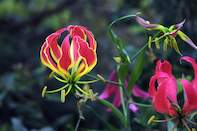
Name
African flame lily (Gloriosa superba)Description
The African flame lily is a climber with coiling tips which allows it to attach to neighbouring plants as support. These tips die off after fruits have formed. The plant grows up to 1m high from a tuber, helping it to survive during droughts. The flowers range in colour from yellow-green to red with flame-shaped petals and extended stamens.
These petals have curly edges and fold backwards in a cage-like manner. The flowers bloom in South Africa’s summer from November to March. The fruit is a 3-compartment leathery capsule and taking up to 10 weeks to ripen.
Habitat
The climbing flame lily extends over low shrubs and rocks and can grow in semi-shade of the sun. It can be found in coastal areas, bushveld, forest, grassland and savannah regions in the northern and eastern areas of South Africa and northwards to Zimbabwe and into East Africa.Field Notes
The flame lily is Zimbabwe’s national flower. When (Queen) Elizabeth visited Zimbabwe as the crown princess in 1947 she received a gift of a diamond brooch designed in the shape of a flame lily during her visit. All parts of the plants are poisonous, but in correct dosages can be used for medicinal purposes to treat intestinal worms and disinfect wounds.
The bright red seeds are used as beads. In Sri Lanka, it is becoming scarce due to its popularity in the pharmaceutical trade, but in Australia, it is an invasive species.